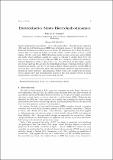| dc.contributor.author | Bazant, Martin Z. | |
| dc.date.accessioned | 2016-04-28T11:45:13Z | |
| dc.date.available | 2016-04-28T11:45:13Z | |
| dc.date.issued | 2015-09 | |
| dc.identifier.issn | 0022-1120 | |
| dc.identifier.issn | 1469-7645 | |
| dc.identifier.uri | http://hdl.handle.net/1721.1/102300 | |
| dc.description.abstract | Despite studying the same subject – electrically induced flow – the fields of electrokinetics (EK) and electrohydrodynamics (EHD) have developed separately, for different types of fluids and interfaces. In colloids or porous media, EK phenomena derive from the electro-osmotic slip of a liquid electrolyte across the neutral electric double layer on a solid surface. On the other hand, EHD phenomena involve poorly conducting neutral fluids and solids, whose interfaces acquire net charge in response to electric fields. Over the past decade, combined theories of EK and EHD have emerged for fluid/solid interfaces, and now Schnitzer & Yariv (J. Fluid Mech., vol. 773, 2015, pp. 1–33) have taken a major step towards unifying EK and EHD for fluid/fluid interfaces. Following previous work by Baygents and Saville, they derive the classical Taylor–Melcher model of droplet EHD as the large-field thin-double-layer limit of the electrokinetic equations, thus elucidating the ubiquitous ‘leaky dielectric’ approximation. Future work could consider the secondary electro-osmotic flow and electrophoretic motion of the drop (neglected here as small perturbations) and allow for more general EK models. | en_US |
| dc.language.iso | en_US | |
| dc.publisher | Cambridge University Press | en_US |
| dc.relation.isversionof | http://dx.doi.org/10.1017/jfm.2015.416 | en_US |
| dc.rights | Creative Commons Attribution-Noncommercial-Share Alike | en_US |
| dc.rights.uri | http://creativecommons.org/licenses/by-nc-sa/4.0/ | en_US |
| dc.source | Prof. Bazant via Erja Kajosalo | en_US |
| dc.title | Electrokinetics meets electrohydrodynamics | en_US |
| dc.type | Article | en_US |
| dc.identifier.citation | Bazant, Martin Z. “Electrokinetics Meets Electrohydrodynamics.” Journal of Fluid Mechanics 782 (September 30, 2015): 1–4. | en_US |
| dc.contributor.department | Massachusetts Institute of Technology. Department of Chemical Engineering | en_US |
| dc.contributor.department | Massachusetts Institute of Technology. Department of Mathematics | en_US |
| dc.contributor.approver | Bazant, Martin Z. | en_US |
| dc.contributor.mitauthor | Bazant, Martin Z. | en_US |
| dc.relation.journal | Journal of Fluid Mechanics | en_US |
| dc.eprint.version | Author's final manuscript | en_US |
| dc.type.uri | http://purl.org/eprint/type/JournalArticle | en_US |
| eprint.status | http://purl.org/eprint/status/PeerReviewed | en_US |
| dspace.orderedauthors | Bazant, Martin Z. | en_US |
| mit.license | OPEN_ACCESS_POLICY | en_US |
